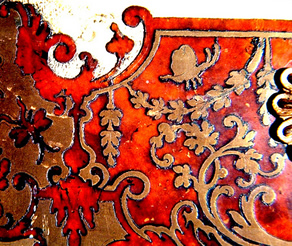Pietra dura literally means 'Hard Stone'. Pieces of highly polished coloured stones, such as marble or lapis lazuli.
This technique originated in Florence and was mainly used to decorate table tops and also cabinet panels.
The designs could be formal or naturalistic, and commonly featured flowers, birds, animals or landscapes.

Drop-Ring Handles
The brass drawer pull is typical of the type found on 17th century fitted and non fitted furniture. Although the level of carving varied from simple circles to florid swags, the basic design of the drop-ring was found on both simple cabinet drawers and ornate pieces that were really designed for the finest residences.
Brass was popular for all furniture detailing at the time.

Emblem Of Louis XIV
Louis XIV of France (r.1661 - 1715) was renowned from the brilliance and theatricality of his court at Versailles.
Known as the Sun King, his personal emblem was a sun with rays of streaming light, echoing Apollo, the Greek god of light. This motif was used to decorate many pieces of, now antique furniture, and architectural features used at the court.

Japanning
The process of Japanning used layers of varnish or shellac to imitate the Oriental lacquerwork that was coveted during the 17th century.
True Japanese and Chinese lacquerwork was difficult and expensive to obtain - so Japanning was really developed by European artisans, who used the technique to decorate the wood and metal of cabinets, screens and mirrors in the then fashionable style.

Ormolu Mounts
This term, from the French or moulu, meaning 'Ground Gold', describes the technique of gilding with bronze using mercury. Decorative details were cast in bronze then gilded with mercury before being mounted onto handmade furniture.
Ormolu mounts were quite often used to protect the edges of veneered pieces. In cheaper imitations the bronze was cast, finished and then lacquered.

Tapestry
Country houses and palaces across Europe used tapestries for their decoration, using them both to cover walls and to upholster chairs. Woven with wool and silk or linen, they were usually pictorial in design.
Many tapestries originated from the Low Countries, in particular Brussels, Paris and also England. In Paris the Gobelins workshops produced designs for Versailles.

Boullework
This form of marquetry is named after the French cabinet maker Andre' Charles Boulle, who was arguably it's finest exponent.
Boullework combines materials like an intricate jigsaw - using materials such as brass, ebonized wood, ivory and tortoiseshell to create the effect of a painting in marquetry. Brass on a tortoiseshell ground is a popular combination.

Carved Wood
Wood carving became a specialized skill during the 17th century. Elaborate designs decorated chairs, chests and tables. Low relief carving, such as the stylized flower motif was used to decorate hardwoods, such as Oak.
Softer woods allowed carvers to create more detailed patterns, such as those seen on French and Italian furniture.

No comments:
Post a Comment